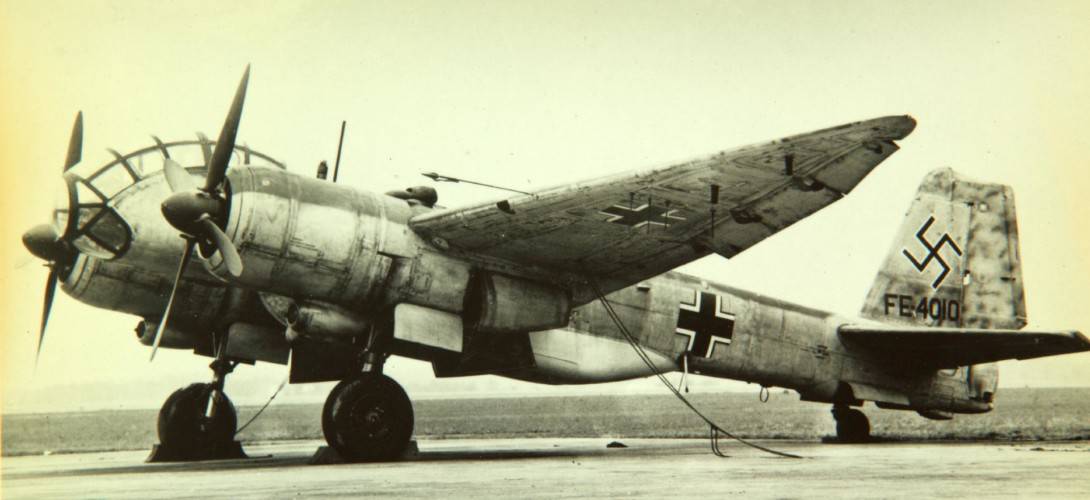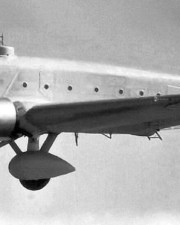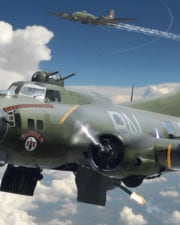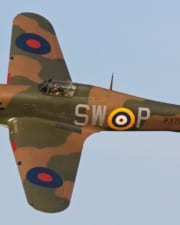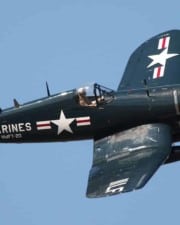The ground forces of Nazi Germany drove into Poland at the beginning of WWII, and bombers of the Luftwaffe, the German air force, began airstrikes on an undefended village, Wieluń, in central Poland. Germany was convinced that their Luftwaffe was unbeatable and far superior to their targeted countries’ air forces with this success.
Table of Contents
The Luftwaffe’s successes and ultimate failure prove that superior technology and expansion of output under war-time conditions can be highly successful.
However, the inefficiency and mismanagement of forces, design programs, and a general lack of knowledge would prove to be Nazi Germany’s downfall.
The Third Reich existed from 1933 to 1945, and the Luftwaffe or air force was the aerial branch of the Wehrmacht. The Luftwaffe fought for aerial supremacy in Southern England to Crete.
It included aircraft spotting enemy convoys in the Arctic, on the North Pacific oceans, and over the German countryside.
The German air force was the German Army’s main support and helped contribute to much of the Third Reich’s early successes from 1939 to 1942. The Luftwaffe continued to support German ground forces, caused havoc for the Allies until Nazi Germany’s ultimate surrender in May of 1945.
Why did the Third Reich feel they had a superior air force? The answer comes in the aircraft they developed. In addition to sophisticated fighter planes, the Luftwaffe had a powerful arsenal of bomber planes to their advantage as well.
Torpedo/Dive Bombers
1. Heinkel He-115

The three-seated Heinkel He-115 WWII Luftwaffe was a seaplane used as a torpedo bomber and performed seaplane duties like reconnaissance and laying mines. The He-115 held two 960 PS (947 hp 720kW) BMW 132 K nine-cylinder air-cooled radial engines. With different configurations, different models could seat four and had unique weapon arrangements.
The HE-115 was used to drop parachute mines in British waters close to ports on the south coast and the River Thames. The aircraft’s greatest success came when stopping shipping operations of Allied convoys from northern Norway. The lightly armed and slow He-115 was less vulnerable in the Artic than near the English Coast.
The Heinkel He 115 contained armament consisting of two 7.92 mm MG 15 machine guns. One was in the nose and the other in the dorsal positions. Later the HE 115 was fitted with a fixed forward-firing 15 mm cannon and two rearward firing 7.92 mm M 17 machine guns.
2. Junkers Ju-87 (Stuka)

The Stuka was a dive bomber and ground attack aircraft first used in combat in 1937. Designed with inverted gull wings and a fixed spatted undercarriage, the aircraft-led air assaults in 1939. Stukas were essential to the conquest of Norway, the Netherlands, Belgium, and France in 1940. About 6,500 Ju-87s were built between 1936 and 1944.
Before the Junkers Ju-87 was fully successful, it went through six prototypes and design changes. The final plane had a single-center wing section and two outer sections using four universal joints. This design created an inverted gull wing pattern. This shape gave the pilot better ground visibility.
The armament on the plane was two 7.92 mm MG 17 machine guns, one in each wing and operated by a pneumatic system. The read gunner had access to one 7.92 mm M 15 machine gun for defensive purposes. The bomber could carry a 500 kg bomb if there were no rear gunner.
3. Junkers Ju-88

This aircraft is a twin-engine and versatile aircraft called a Schnelbomber (fast bomber) designed to be too quick for Allied fighters to catch. It quickly became a very adaptable German combat aircraft. The Junker Ju-88 was a bomber, night fighter, torpedo bomber, and flying bomb.
No other aircraft – Allied or Axis – was as continually modified as the Ju-88. The Junkers design was a great example of German philosophy using good airframes and modifying them for different tasks. This was the German idea of simplifying production and combat operations.
An American citizen, Alfred Gassner, designed the Ju-88, and more than 9,000 of the planes were bombers. The Ju-88 was an effective night fighter when fitted with German aerial radar, the Telefunken FuG-212. This aircraft scored many kills early in the war when as night marauders, they targeted British bombers over UK airfields.
Heavy Bombers
3. Dornier Do-217

The bomber was eventually developed with a large bomb capacity for dive-bombing maritime strike capabilities using glide bombs and long-range missions. On the Eastern and Western Fronts, the Dornier Do-217 was a strategic bomber, torpedo bomber, and reconnaissance aircraft.
It helped direct ground assaults or anti-shipping strikes in the Battle of the Atlantic and Battle of Normandy. The Dornier Do-217 was considered a multi-role aircraft, but it did not march well against Allied fighters.
The cockpit and crew areas of the Do-217 were forward in the fuselage area, and heavy glazing produced noticeable tapering of the aft fuselage. The result was a pencil-like shape. The engines were fitted on an arrangement similar to a high-wing monoplane, and the tail resembled a Split-T.
Armament was fitted for a needed mission, and typical loadouts involved 7.92 mm rapid-firing guns, plus 20mm cannons. The internal-external bomb load could be over 8,000 pounds.
4. Heinkel He-177

The Luftwaffe used the Heinkel He-177 during WWII as the only long-range heavy bomber in the German air force. The payload/range capacity of the Heinkel He 177 was almost like the four-engine heavy bombers used by the Allies in the European war front. This bomber had a higher cruising and maximum speed that its Allied Counterparts.
The aircraft suffered from many design function flaws, one of which was the need for at least 2,000 horsepower engines. The engine’s size was unproven at the time, and the Daimler-Benz BD 606 system was collected in addition to cramped nacelles, which caught fire easily. The bomber became known as Reich’s lighter.”
A functional design came too late in the war to play any role. Some planes were used on the Eastern Front, and it was seen in an attack on Veliklyle Luki in 1944. However, that was the last time the bomber was used in the War.
5. Junkers Ju-290
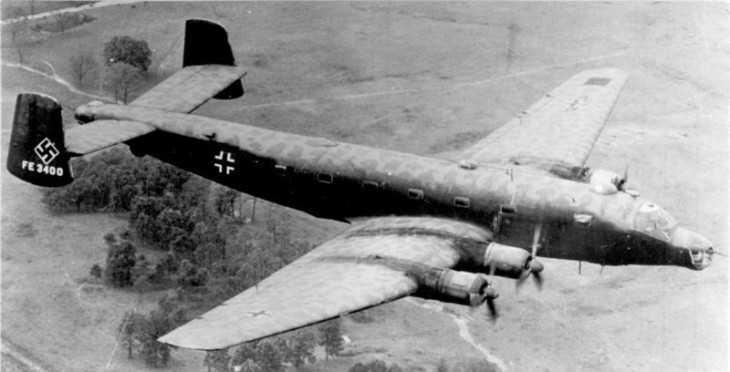
Junkers Ju-920 was a four-engine long-range transport and heavy bomber used by the Luftwaffe. It was developed from an airliner and was intended to replace the slow Focke-Wulf Fw200 Concord as a bomber but was mainly used as a transport.
In 1943, Hitler was shown a prototype of the Junkers Ju-290 and he was impressed by its potential. He asked for a Ju-290 for his personal use. Because of Hitler’s demands, the aircraft was fitted with a passenger compartment in front of the aircraft made for Hitler, protected by a 12mm armor plate and 50mm bulletproof glass. A special escape hatch was fitted, and a parachute was built into Hitler’s seat.
Hans Baur flew the aircraft to the Munich Airport on March 1945 but landed just as an air-raid alert was sounded. He parked the plane in a hanger. When he returned to fly the plane, Baur discovered American bombers had destroyed the hanger and the aircraft.
Medium Bombers
6. Heinkel He-111
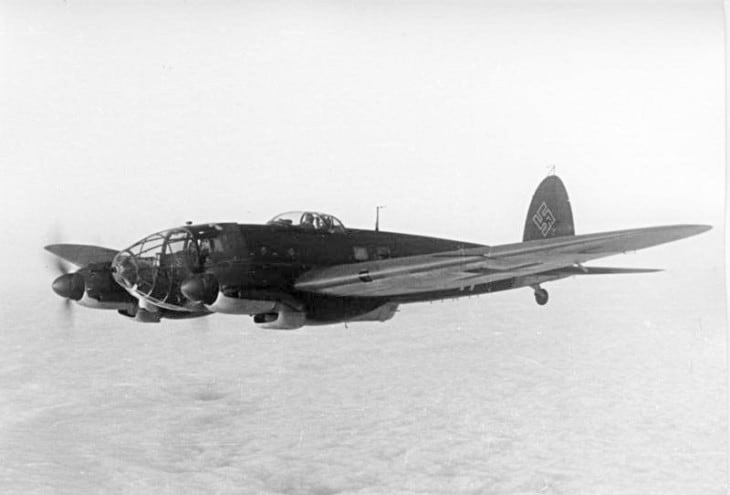
The Heinkel He-111 was a “sheep in wolf’s clothing” and was one of the most important German medium bombers of World War II. The design was a streamlined form with elliptical wing mainplanes. The He-111 served in the entire war effort and could be seen on any front where the Germans fought.
This medium bomber became needed because of battlefield configurations. Germans did not like heavy bombers; it believed in grouping bombers together. To the Luftwaffe, fighting was difficult in heavy bombers – which the Allies used.
Heinkel He-111 was thought to be capable bombers, but in the Battle of Britain in 1940, the weaknesses of the He-11 proved the He-111s were to slow to outrun danger, and their gun network lacked all-around capabilities. Yet, the He-111 was an effective bomber and hit British military infrastructures like radio centers and airfields and even London.
Beginning with the Soviet Union’s invasion in 1941, the He-111 was used over an unforgiving Eastern Front for years. Low-flying ground attacks plus transport services were successful because of the He-111’s.
7. Junker Ju-388
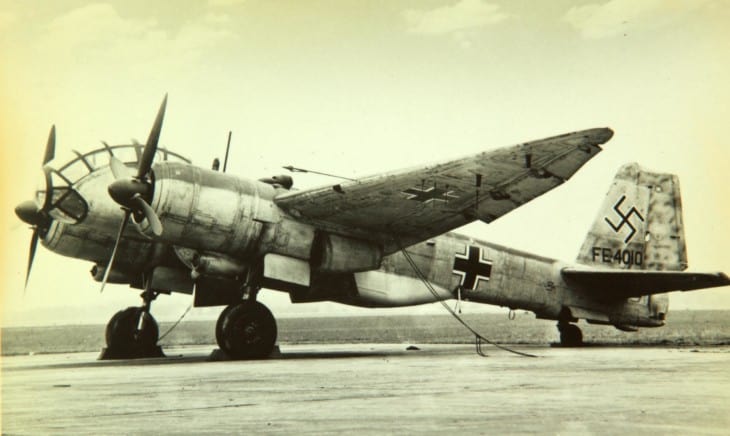
The Junker-Ju-388 was designed for high altitude operation ad included a pressurized cockpit for its crew. The Ju-388 was introduced late in the war and production problems, and the deteriorating war meant that few were built and used.
he medium bomber’s new design was devised to fight the American B-29 bomber, which was expected to attack from 35,000 feet. Ju-388 bombers were affectionately named Stortebecker after a blood-thirsty Baltic Sea pirate.
To improve the Ju-388’s performance, the plane was stripped of most of its defensive armament. A single remote-control turret replaced the armament on the plane in the tall section that contained two 13 mm MG 131 machine guns armed by a periscope in the cockpit. One gun was mounted above the other; now, the Ju-388 tail turret contained an excellent fire field and could shoot directly to the rear.
The Ju-388 used the BMW 01 radial and Jumo 213 series V12 engines. The Ju-388 maintained a similar speed as the existing Luftwaffe night flights, but the Ju-388 could maintain the speed at higher altitudes. It was thought that the aircraft was capable of reaching 435 mph.
Light Bombers
8. Arado Ar 234
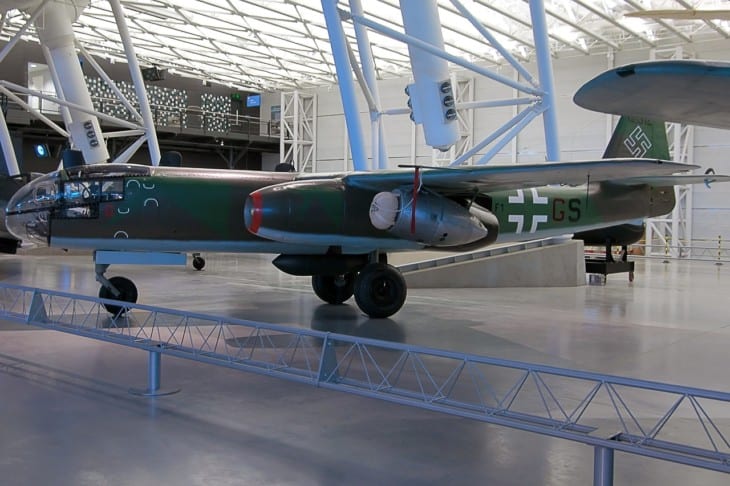
In the closing stages of WWII, Germany built the world’s first operational jet-powered bomber, the Arado Ar 234 was produced in limited numbers and was used for reconnaissance missions. When used as a bomber, the aircraft proved to be almost impossible to intercept.
The Arado Ar 234 B Blitz (lightning) flew a mission over the Allied beachhead in Normandy in August 1944. The aircraft hit a maximum speed of 459 miles per hour and easily eluded the Allied piston-engine fighters. The Ar-234 was not as famous as the Messerschmitt Me 262 jet, but it provided excellence in the missions it ran.
The aircraft was a single-seat, twin-engine jet bomber with RATQ. It had a wingspan of 47 ft 4 in and a length of 141 4t 6in. Empty, the bomber weighed 10,000 lbs, and its top speed was 459 mph.
9. Dornier Do-17
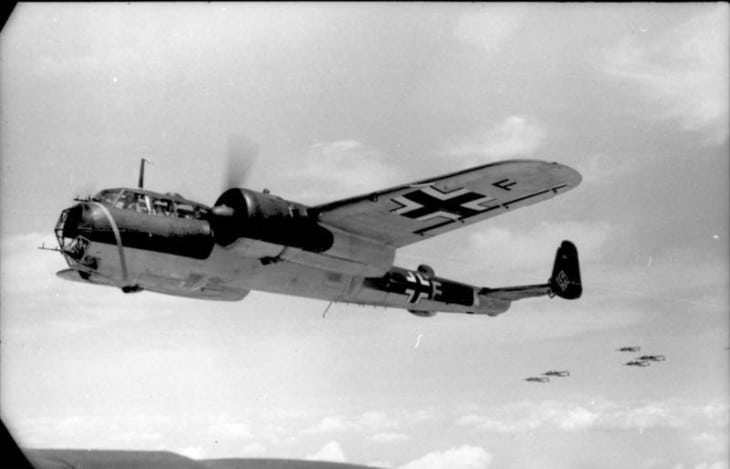
The Dornier Do-17 affectionately called the Flying Pencil. It was a light bomber and manufactured by the Dornier Company. The aircraft was specifically developed as a fast bomber that could be so fast it could outmaneuver Allied fighter planes.
The Do-17 had two engines installed on a wing structure, or shoulder, and had a double configuration on the tail. This tail configuration was a popular design because of maneuvering capabilities at lower altitudes. The Allies found the Do-17 more difficult to hit than other German Bombers.
The Do-17 was used in the first three years of the war and operated in different roles in the Condor Legion. It was the main bomber plane of the German air war in 1939-1940. The Do-17 saw significant action in every major campaign theater as a front line aircraft. At the end of 1941, the effectiveness of the Do-17 was limited since its bomb load, and the range was limited.
Related Posts
